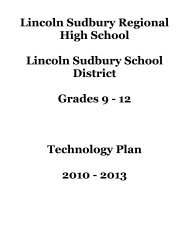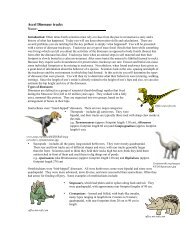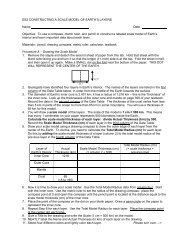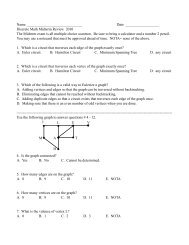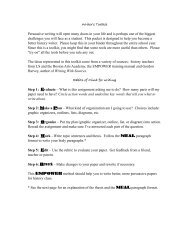Fetal Pig Dissection Introduction: Today, we begin a new chapter in ...
Fetal Pig Dissection Introduction: Today, we begin a new chapter in ...
Fetal Pig Dissection Introduction: Today, we begin a new chapter in ...
Create successful ePaper yourself
Turn your PDF publications into a flip-book with our unique Google optimized e-Paper software.
<strong>Fetal</strong> <strong>Pig</strong> <strong>Dissection</strong><strong>Introduction</strong>:<strong>Today</strong>, <strong>we</strong> <strong>beg<strong>in</strong></strong> a <strong>new</strong> <strong>chapter</strong> <strong>in</strong> our study of biology. In the first half of the year <strong>we</strong>looked at how the smallest units of life work, reproduce and pass on their genes. Dur<strong>in</strong>gthe next several months <strong>we</strong> are go<strong>in</strong>g to look at how larger organisms meet thecharacteristics of life. The biggest emphasis will be on mak<strong>in</strong>g the connections bet<strong>we</strong>enstructure and function with<strong>in</strong> these organisms.To <strong>beg<strong>in</strong></strong> our study of the connections bet<strong>we</strong>en structure and function <strong>we</strong> are go<strong>in</strong>g toexam<strong>in</strong>e the anatomy of a fetal pig. The pigs <strong>we</strong> will dissect <strong>in</strong> this class <strong>we</strong>re neverborn. Their mother passed away and their bodies <strong>we</strong>re prepared so that <strong>we</strong> might learn.This gives all of us a tremendous responsibility. Because these pigs gave their lives forour learn<strong>in</strong>g <strong>we</strong> must be compelled by their sacrifice to learn as much as <strong>we</strong> can out ofrespect. Should you choose to disrespect your pig <strong>in</strong> any way, your transgression will bemet with serious consequences, <strong>in</strong>clud<strong>in</strong>g dismissal from class for the day, failure onclass grades, or failure on quizzes and tests.That be<strong>in</strong>g said, I honestly expect noth<strong>in</strong>g but wonderful behavior from everyone. All ofyou have demonstrated so much maturity dur<strong>in</strong>g this year that I th<strong>in</strong>k this will be one ofthe highlights of our class.Structure:This unit is entirely hands-on. You will work <strong>in</strong> pairs to dissect and learn from your pig.You are responsible for your pig and its’ <strong>we</strong>ll-be<strong>in</strong>g at all times. The grade for this unitwill be broken down <strong>in</strong>to three basic parts.1) Homework grade: you will receive a homework packet, which will becollected at the end of the unit. This packet will be graded for accuracy andeffort. I would try and spend a half-hour on it every night.2) Practical grade: there will be a practical quiz and a practical test dur<strong>in</strong>g thisunit. These assessments will have you identify structures (and somefunctions) of the pig anatomy from several of our pigs. Your preparation forthese will consist of follow<strong>in</strong>g through the dissection manual exactly andlocat<strong>in</strong>g every structure.You will all have tons of questions dur<strong>in</strong>g the next few <strong>we</strong>eks. But, keep <strong>in</strong> m<strong>in</strong>d that Iam one person and I cannot ans<strong>we</strong>r everyone’s questions at once. Just be patient with meand polite to each other and I will be able to work with each group. Also, if your groupcan help others with their questions I encourage you to do so. Thanks so much, this isreally go<strong>in</strong>g to be great!-Mr. Elenbaas
Organs and Parts you need to know on The <strong>Pig</strong>When learn<strong>in</strong>g these structures, it is helpful for you to learn them <strong>in</strong> a way that makessense, i.e. <strong>in</strong> the way they are connected by function. For example, the ur<strong>in</strong>ary system:the kidney is connected to the ureter, which is connected to the ur<strong>in</strong>ary bladder, whichis connected to the urethra.Below is a list of organs, which I tried to put <strong>in</strong>to general sections based on function.DigitsUmbilical cordAnal open<strong>in</strong>gUrogenital open<strong>in</strong>gMammary glandTongueTeethGlottisEpiglottisEsophagusStomachPyloric valveSmall <strong>in</strong>test<strong>in</strong>e:Duodenum, jejunum, ileumCaecumLarge <strong>in</strong>test<strong>in</strong>e:Colon, rectumLiverGall bladderSpleenPancreasOvaryUter<strong>in</strong>e tubesUter<strong>in</strong>e hornsUterusVag<strong>in</strong>aUrogenital s<strong>in</strong>usVulvaProcessus vag<strong>in</strong>alisEpididymisTestisDuctus deferensPenisUr<strong>in</strong>ary bladderUreterKidneyurethraDiaphragmLungsTracheaLarynxSubclavian ve<strong>in</strong>sAnterior vena cava (precava)Brachiocephalic ve<strong>in</strong>sInternal and external jugular ve<strong>in</strong>sPosterior vena cava (postcava)Renal ve<strong>in</strong>sCoronary ve<strong>in</strong>Common iliac ve<strong>in</strong>Umbilical ve<strong>in</strong>Pulmonary arteryUmbilical arteriesAortic archDuctus arteriosisBrachiocephalic arteryCommon carotid arteriesSubclavian arteriesIntercostal arteriesRenal arteriesIliac arteriesThoracic aortaAbdom<strong>in</strong>al aortaCoronary arteryLeft and right ventricleLeft and right atrium (or auricle)PericardiumMen<strong>in</strong>gesCerebrumCerebellumMedulla oblongataOlfactory bulbThymusThyroid
<strong>Fetal</strong> <strong>Pig</strong> LabCheck off each organ/structure as you locate it on your pig. Ans<strong>we</strong>r questions where<strong>in</strong>dicated.I. External Anatomy of the <strong>Pig</strong>A. Age:i. By us<strong>in</strong>g this table and measur<strong>in</strong>g the length of your pig <strong>in</strong> mmyou can determ<strong>in</strong>e the approximate fetal age of the pig. This is thenumber of days s<strong>in</strong>ce its’ father’s sperm fertilized its’ mother’segg. Measure your pig from snout to rump (this does not <strong>in</strong>cludethe length of the tail)Size (mm) cm Age (days s<strong>in</strong>cefertilization)11 1.1 2117 1.7 3528 2.8 4940 4.0 56220 22.0 100300 33.0 Full term (112-115)ii. How old is your fetal pig? ____________________________B. External features of the body:i. ____ Headii. ____ Neckiii. ____ Trunkiv. ____ Tail
v. ____ Appendages1. Head of the <strong>Pig</strong>:a. ____ Eyes: Are they open yet? _________b. ____ Earsc. ____ Nostrilsd. ____ Mouth: Can you see the tongue? ______2. Appendages:a. ____ Digits: How many digits does the pig have oneach foot? _____________________________b. Note that the first digit (thumb) is miss<strong>in</strong>g and thesecond and fifth digits are reduced <strong>in</strong> size. Howmany digits does the pig walk on, on each foot?_____________________________________3. Trunk:a. ____ Thorax: The body cavity that extends from theneck to the diaphragm (the chest area)b. ____ Sternum: The bone <strong>in</strong> the center of the chest towhich the ribs attach <strong>in</strong> front.c. ____ Abdomen: Body cavity posterior to the thoraxd. Umbilical cord: Still partially attached to the ventralside of the abdomen. This used to be attached to theplacenta <strong>in</strong> the womb of the mother.e. ____ Mammary glands: Nipples or teats found onthe ventral surface. How many mammary glandsdoes your pig have? Why are there so many?f. Anal open<strong>in</strong>g: Located directly under (ventral) tothe tail.4. Sex determ<strong>in</strong>ation: You are responsible for know<strong>in</strong>g thereproductive structures on both a male and female pig.
First, determ<strong>in</strong>e the sex of your pig. Then f<strong>in</strong>d a group topartner with that has a pig of the opposite sex. You will beresponsible for show<strong>in</strong>g each other the relevant parts.a. Female external anatomy:i. ____ Urogenital open<strong>in</strong>g: Foundimmediately ventral to the anal open<strong>in</strong>g; thisopen<strong>in</strong>g can be recognized by a fleshyprotuberance (vulva).b. Male external anatomy:i. ____ Urogenital open<strong>in</strong>g: Look for a smallhole just posterior to the base of theumbilical cord.ii. ____ Scrotal sacs: Two slight s<strong>we</strong>ll<strong>in</strong>gsbeh<strong>in</strong>d the h<strong>in</strong>d legs.iii. ____ Penis: This is the muscular tube ly<strong>in</strong>gunder the sk<strong>in</strong>, runn<strong>in</strong>g posteriorly from theurogenital open<strong>in</strong>g. You can feel this underthe sk<strong>in</strong>.What is the sex of your pig? ___________Who will be your partner group? __________Do male pigs have mammary glands? _________II.Digestive System: You are about to <strong>beg<strong>in</strong></strong> your exam<strong>in</strong>ation of the alimentarycanal, consist<strong>in</strong>g of: mouth, pharynx, esophagus, stomach, small <strong>in</strong>test<strong>in</strong>e,large <strong>in</strong>test<strong>in</strong>e, and a number of glands (liver, pancreas)A. ____ Mouth: This is the open<strong>in</strong>g of the digestive system. Cut jawsstart<strong>in</strong>g at the corners of the mouth and cut all the way through thecartilage to the ears. Deepen your cuts until the mouth opens freely. Donot cut <strong>in</strong>to the back of the throat.i. ____ Tongue
ii. ____ Papillae: Bumps on the surface of the tongueiii. ____ Teeth: How many teeth can you count <strong>in</strong> your pig’s mouth?1. Do both jaws move up and down or just one? ________iv. ____ Pharynx: The throat (back of mouth)v. ____ Epiglottis: The small white tab found at the back of thepharynx. This is made of cartilage. The jaw must be open verywide to see this.vi. ____ Esophagus: Only the open<strong>in</strong>g, or glottis, of the esophagus isvisible at this stage. It lies beyond (dorsal to) the epiglottis. It isessentially, the open<strong>in</strong>g.vii. ____ Larynx: Not visible yet, but feel for the “Adam’s apple” fromthe outside of the pig’s throat. You will see this when the throatarea is dissected later.B. ____ Abdom<strong>in</strong>al cavity: Now you are ready to exam<strong>in</strong>e the viscera(<strong>in</strong>ternal organs) of the abdom<strong>in</strong>al cavity. Read through all of the stepsfirst, then go through them aga<strong>in</strong> perform<strong>in</strong>g each step.i. Place pig on its dorsal side (belly up)ii. Lift the th<strong>in</strong> wall of the abdomen above the umbilical cord, hold<strong>in</strong>git away from the <strong>in</strong>ternal organs. Insert the f<strong>in</strong>e po<strong>in</strong>t of yourscissors, or scalpel, through the wall of the abdomen where lifted.Cut through the sk<strong>in</strong> and muscle to the cavity. Always cut with anupward motion to avoid damag<strong>in</strong>g the <strong>in</strong>ternal organs.iii. Cut <strong>in</strong> a straight l<strong>in</strong>e own the midl<strong>in</strong>e of the pig from the umbilicalcord to the bottom of the sternum. DO NOT CUT THROUGHTHE RIBS or DIAPHRAGM.iv. Refer to the diagrams below for help on the follow<strong>in</strong>g directions:1. Cut around the umbilical cord. The umbilical ve<strong>in</strong> extendsfrom the <strong>in</strong>side of the umbilical cord to the liver, the largegrown organ <strong>in</strong> the abdomen. You will have to cut theumbilical ve<strong>in</strong>, but note it first.
2. Female Only: Jo<strong>in</strong> the cuts from either side of theumbilical cord at a po<strong>in</strong>t just posterios to the cord. Then,cont<strong>in</strong>ue this cut down bet<strong>we</strong>en the legs.3. Male Only: Do not jo<strong>in</strong> the cuts from either side of theumbilical cord. Instead, cont<strong>in</strong>ue the two cuts separatelytoward the posterior of the animal, bet<strong>we</strong>en the h<strong>in</strong>d legs.This is to avoid cutt<strong>in</strong>g the penis, which is just below thesk<strong>in</strong>.v. In both cases, just <strong>in</strong> front of the h<strong>in</strong>d legs, cut laterally through thebody on either side. Make another two lateral cuts at the top of theabdomen, expos<strong>in</strong>g but not damag<strong>in</strong>g the diaphragm. You shouldnow have two flaps which can be opened sideways to expose the<strong>in</strong>ternal organs of the abdomen.vi. Remove and throw away any stray pieces of red or blue latex<strong>in</strong>side the abdom<strong>in</strong>al cavity. Dra<strong>in</strong> the “juice” and gently r<strong>in</strong>se outthe abdom<strong>in</strong>al cavity of your pig.vii. As demonstrated <strong>in</strong> class, fasten the pig to the dissect<strong>in</strong>g tray withtwo pieces of str<strong>in</strong>g.C. Abdom<strong>in</strong>al Organs: You are now ready to locate the follow<strong>in</strong>gabdom<strong>in</strong>al organs.
i. ____ Mesentery: Th<strong>in</strong> membrane cover<strong>in</strong>g the organs. You cutthrough this when open<strong>in</strong>g the abdom<strong>in</strong>al cavity.ii. ____ Liver: Large reddish brown organ at the anterior end of theabdom<strong>in</strong>al cavity.iii. ____ Gall bladder: Gently lift the liver at the posterior end. Youwill see a greenish, or colorless, sac on the underside of the liver.This is where a digestive juice called bile is tored.iv. ____ Stomach: A bag-like structure best seen lift<strong>in</strong>g the liverfurther.v. ____ Pancreas: Lift the stomach from its posterior end. Thepancreas is a gray or yellowish mass that has the texture ofcauliflo<strong>we</strong>r. As a part of the digestive system, the pancreassecretes digestive enzymes like peps<strong>in</strong>. It also secretes a hormonecalled <strong>in</strong>sul<strong>in</strong>.vi. ____ Pyloric valve: A hard s<strong>we</strong>ll<strong>in</strong>g at the exit of the stomachwhere it connects to the small <strong>in</strong>test<strong>in</strong>e. Feel for this.vii. ____ Small <strong>in</strong>test<strong>in</strong>e: Light colored mass of tub<strong>in</strong>g lead<strong>in</strong>g directlyfrom pyloric valve; connects with large <strong>in</strong>test<strong>in</strong>e. Differentsections <strong>in</strong> order of flow are called: duodenum, jejunum, andileum.viii. ____ Large <strong>in</strong>test<strong>in</strong>e: Darker-colored sometimes green mass oftub<strong>in</strong>g found <strong>in</strong> the abdomen. Made of two parts.1. ____ Colon: First part of large <strong>in</strong>test<strong>in</strong>e, tightly coiled andgreen <strong>in</strong> color.2. ____ Rectum: Posterior part of large <strong>in</strong>test<strong>in</strong>e that leads tothe anal open<strong>in</strong>g. It is straight, not coiled. To see it, pushaside the colon.ix. ____ Caecum: A dead end pouch at the junction of the small andlarge <strong>in</strong>test<strong>in</strong>e. This organ is homologous to the appendix <strong>in</strong> yourbody. This can be very hard to f<strong>in</strong>d, try trac<strong>in</strong>g the path of thesmall <strong>in</strong>test<strong>in</strong>e until it reaches the large.
x. ____ Spleen: A long, flat, brownish organ located near the stomachon the pig’s left side (this is not a digestive organ, it stores bloodand functions <strong>in</strong> the immune system)xi. ____ Anal open<strong>in</strong>g: Ventral to your pig’s tail.xii. What is miss<strong>in</strong>g? How does the food get from the mouth to thepig’s stomach? _____________________________________III.Urogenital System: The ur<strong>in</strong>ary system is closely l<strong>in</strong>ked to the structures ofthe reproductive system <strong>in</strong> both the male and female pig. When <strong>we</strong> refer toboth of these systems collectively <strong>we</strong> use the term urogenital. Remember,regardless of the sex of your pig, you are expected to know the systems ofboth the female and male.A. Ur<strong>in</strong>ary System:i. ____ Kidneys: two bean shaped structure located on the dorsalwall of the abdomen.ii. ____ Mesentary: sh<strong>in</strong>y membrane cover<strong>in</strong>g the kidneys and l<strong>in</strong><strong>in</strong>gthe body cavity. Remove the mesentery and carefully expose thekidneys and ureters.iii. ____ Ureters: thick white tubes runn<strong>in</strong>g posteriorly from thekidneys to the ur<strong>in</strong>ary bladder. These carry the ur<strong>in</strong>e from thekidneys to the bladder.iv. ____ Ur<strong>in</strong>ary bladder: the storage organ for ur<strong>in</strong>e. This is anelongated sac ly<strong>in</strong>g bet<strong>we</strong>en two large blodd vessels called theumbilical arteries. The outermost tip of the ur<strong>in</strong>ary bladder leadsto the umbilical cord. Look for the entrance of the ureters <strong>in</strong>to theblader at the base of the bladder, at the opposite end from theumbilical cord.v. ____ Urethra: The tube that runs from the ur<strong>in</strong>ary bladder <strong>in</strong>to theurogenital s<strong>in</strong>us <strong>in</strong> the female pig and through the penis <strong>in</strong> the male(See reproductive systems for more on these structures). You will
probably not see much of the urethra until you dissect thereproductive system.B. Female Reproductive System: Grabb<strong>in</strong>g both h<strong>in</strong>d legs, carefully crackthe pelvis, splay<strong>in</strong>g each leg far to the side. Next, carefully cut throughthe pelvis bone bet<strong>we</strong>en the h<strong>in</strong>d legs, so the legs will lie flat. Do notdamage the tissues ly<strong>in</strong>g beneath the bond.i. ____ Ovaries: Two small bean-shaped bodies <strong>in</strong> the lo<strong>we</strong>r part ofthe abdomen. You must move the <strong>in</strong>test<strong>in</strong>es aside <strong>in</strong> order to seethem.ii. ____ Uter<strong>in</strong>e tubes: Lift an ovary with a probe and look on theundrside of the ovary for a t<strong>in</strong>y, coiled tube.iii. ____ Uter<strong>in</strong>e horns: The uter<strong>in</strong>e tubes broaden <strong>in</strong>to thicker, flattertubes, this is where the embryos develop <strong>in</strong> pigs (not <strong>in</strong> the uterusas <strong>in</strong> human). These are homologous organs to the fallopian tubes<strong>in</strong> women.iv. ____ Uterus: Somewhat v-shped structure formed at the junctionof the two uter<strong>in</strong>e horns. Unlike the human, this is not the site ofembryo development.v. ____ Vag<strong>in</strong>a: A thick muscular structure which is a posteriorcont<strong>in</strong>uation of the uterus. You will have to push apart the severedpelvic bones and clear away membrane so that you can trace theuterus to the vag<strong>in</strong>a.vi. ____ Urethra: Tube which extends from the bottom of the bladderand jo<strong>in</strong>s with the vag<strong>in</strong>a to form the urogenital s<strong>in</strong>us <strong>in</strong> the femalepig. This is not a reproductive structure <strong>in</strong> the female pig.vii. ____ Urogenital s<strong>in</strong>us: Located about an <strong>in</strong>ch from the posteriorend of the female pig; the junction of the vag<strong>in</strong>a and the urethra.This tube leads to the urogenital open<strong>in</strong>g <strong>in</strong> the female pig.viii. ____ Urogenital open<strong>in</strong>g: Open<strong>in</strong>g to the urogenital s<strong>in</strong>us; foundventral to the anal open<strong>in</strong>g <strong>in</strong> the female pig.
ix. ____ Vulva: Fleshy protuberance found at the cover<strong>in</strong>g/open<strong>in</strong>g ofthe urogenital system.C. Male Reproductive System: cut through the pelvic bone <strong>in</strong> the areabet<strong>we</strong>en the top of the h<strong>in</strong>d legs so that the legs will lie flat. Do not harmthe underly<strong>in</strong>g structuresi. ____ Processus vag<strong>in</strong>alis: This is an elongated membranous sacthat conta<strong>in</strong>s the testis. To f<strong>in</strong>d it, cut the the surface sk<strong>in</strong> andmuscle close to the place where the h<strong>in</strong>d leg jo<strong>in</strong>s the body (at thelocation of the scrotal sacs). The processus vag<strong>in</strong>alis can now beslipped out. Carefully do this on each side of the pig.ii. ____ Testis: Cut open the membrane of one of the processusvag<strong>in</strong>alis to reveal the small brown organs where sperm areproduced.iii. ____ Epididymis: T<strong>in</strong>y, tightly coiled white tubes alongside thetestis. This is where the sperm are stored.iv. ____ Ductus deferens: A cont<strong>in</strong>uation of the epididymis; leas fromthe epididymis to the ureter. Follow the ductus deferens (a superth<strong>in</strong>,white cord) as it loops over the ureter near the attachment ofthe ureter to the bladder. This cord jo<strong>in</strong>s the ureter on its dorsalwall.v. ____ Penis: This is a tricky dissection. Feel for the penis (amuscular tube) runn<strong>in</strong>g under the sk<strong>in</strong> just posterior to theumbilical cord. Remove the cover<strong>in</strong>g of the sk<strong>in</strong> and trace thepenis through the pelvic bond. The penis is a cont<strong>in</strong>uous tube thatruns from the base of the bladder to the urogenital open<strong>in</strong>g.vi. ____ Urethra: Tube lead<strong>in</strong>g from the base of the bladder,cont<strong>in</strong>uous with<strong>in</strong> the penis.
IV.Respiratory System:A. <strong>Dissection</strong> of the neck and thoracic cavityi. ____ Diaphragm: Flat muscle at the base of the thoracic cavity,attached to body wall. This separates the thoracic cavity from theabdom<strong>in</strong>al cavity.Now, cut through the rib cage with scissors on a l<strong>in</strong>e from the diaphragm to just to theright of the sternum (breastbone) up to your pig’s ch<strong>in</strong>. It is critical the you cut only theribs so as not to damage the delicate tissues below. Make two lateral cuts just posterior tothe front legs to make <strong>new</strong> flaps. You have now cut through the diaphragm to expose thethoracic cavity more clearly.ii. ____ Thymus: The thymus gland fills much of the throat are andmay extend over the heart. Confirm with the teacher that you havefound this. Then you can remove some of the thymus to give youa clear view of the neck region. The thymus is a part of theendocr<strong>in</strong>e system, not the respiratory.B. Respiratory System: Review the structures you have already observedi. ____ Nostrilsii. ____ Mouthiii. ____ EpiglottisIn the neck, where you have just dissected, f<strong>in</strong>d:iv. ____ Larynx: the voice box, or Adam’s apple; an enlarged whitestructure <strong>in</strong> the throat.v. ____ Thyroid gland: brownish bean-shaped structure at the base ofthe larynx. This is an endocr<strong>in</strong>e gland that produces hormones,which control metabolism. This is not a respiratory organ.vi. ____ Trachea: The “w<strong>in</strong>dpipe” a tube lead<strong>in</strong>g from the larynx tothe lungs.vii. ____ R<strong>in</strong>gs of cartilage: You can feel and see these r<strong>in</strong>gs on thetrachea. They hold the trachea open for constant air flow.
viii. ____ Esophagus: Push aside the trachea and note a smaller, moreflexible tube ly<strong>in</strong>g dorsal to the trachea. This tube carries foodfrom the mouth to the stomach and is not part of the respiratorysystem.The esophagus is part of the ____________ system.Why doesn’t the esophagus need r<strong>in</strong>gs of cartilage?_________________________________________In the thoracic cavity, f<strong>in</strong>d:ix. ____ Lungs: Spongy and un<strong>in</strong>flated. Note the lobes <strong>in</strong>to whichthey are divided. Cut a small piece of lung tissue and place <strong>in</strong> abeaker of water. Does the tissue float or s<strong>in</strong>k? ____________Why? ________________________________Now <strong>in</strong>sert a straw <strong>in</strong>to the trachea and blow to <strong>in</strong>flate the lungs.Cut another piece of lung tissue (preferably a piece that turnedvery white) and place <strong>in</strong> water. Does it float or s<strong>in</strong>k? _____Why? ________________________________V. Circulatory System: the directions left and right refer to your pig’s left andright, not your own.A. External anatomy of the hearti. ____ Heart: lies <strong>in</strong> the center of the chest bet<strong>we</strong>en the lungs.ii. ____ Pericardium: tough membrane cover<strong>in</strong>g the heart. Removeit.iii. ____ Left ventricle: large chamber on the lo<strong>we</strong>r left side of theheart (pig’s left). Pumps oxygenated blood out of the aorta to thebody.iv. ____ Right ventricle: also called the right auricle. Dark red flap onthe upper part of the hear ly<strong>in</strong>g over the right ventricle. Pumpsdeoxygenated blood through the pulmonary artery to the lungs.
v. ____ Coronary artery: (P<strong>in</strong>k) Artery runn<strong>in</strong>g diagonally down theventral side of the pig’s heart from its upper left to its lo<strong>we</strong>r right.Separates the two ventricles.vi. ____ Left atrium (auricle): Dark red flap on the upper part of theheart ly<strong>in</strong>g over the left ventricle. It receives oxygenated bloodfrom the lungs and is emptied <strong>in</strong>to the left ventricle.vii. ____ Right atrium (auricle): Over the right ventricle. It receivesdeoxygenated blood from the body and is emptied <strong>in</strong>to the rightventricle.B. Blood vessels attached to the hearti. ____ Pulmonary artery: Large, hard, white tube lead<strong>in</strong>g out of theright ventricle, ly<strong>in</strong>g bet<strong>we</strong>en the two atria. This branches <strong>in</strong>to aleft and right branch, one for each lung.ii. ____ Aorta: Large, hard, white tube whose base is covered by thepulmonary artery. It leads out of the left ventricle, arches throughthe branches of the pulmonary, and turns posteriorly to head downthrough the thoracic and abdom<strong>in</strong>al cavities.iii. ____ Aortic arch: Curved part of the aorta that comes out of theheart. Note that two arteries branch from the (top) of the arch tosend blood to the head and upper body.iv. ____ Ductus arteriosus: This is a special structure found only <strong>in</strong>the fetus; it short circuits the usual flow of blodd to the lungs bysend<strong>in</strong>g blood from the pulmonary artery directly <strong>in</strong>to the aorta.To f<strong>in</strong>d it, follow the pulmonary artery up from the heart <strong>in</strong>to itsleft branch. There you will see a short connection to the aorta.This closes after birth, when the lungs <strong>beg<strong>in</strong></strong> to function.v. ____ Anterior vena cava: Also called the pre-cava, this is the largevessel enter<strong>in</strong>g the right atrium.vi. ____ Posterior vena cava: Also called the post-cava. Lift the heartup towards the head of your pig. The postcava runs from theabdom<strong>in</strong>al cavity, through the diaphragm <strong>in</strong>to the right atrium.
C. The Venous System: This system is <strong>in</strong>jected with blue latex. All of thebones and muscle tissue bet<strong>we</strong>en the heart and neck must be carefullyremoved <strong>in</strong> order to see the blood vessels clearly. Remember, ve<strong>in</strong>s carryblood toward the heart from the body. Arteries carry blood from the hearttoward the body. Blood <strong>in</strong> the ve<strong>in</strong>s is rich <strong>in</strong> (O 2 /CO 2 ) __________ andpoor <strong>in</strong> ___________ . Blood <strong>in</strong> the arteries is rich <strong>in</strong> ___________andpoor <strong>in</strong> ___________ . Exceptions to this rule are the pulmonary arteryand the umbilical arteries and ve<strong>in</strong>s. Why? _____________________i. Ve<strong>in</strong>s above the heart1. ____ Anterior vena cava2. ____ Brachiocephalic ve<strong>in</strong>: Also called the <strong>in</strong>nom<strong>in</strong>ateve<strong>in</strong>. Follow the precava up to the po<strong>in</strong>t where it parts <strong>in</strong>totwo branches. Each of these short branches is abrachiocephalic ve<strong>in</strong>.3. ____ Internal jugulars: A pair of ve<strong>in</strong>s, on either side of thethroat close to the larynx; they dra<strong>in</strong> blood from the head.4. ____ External jugulars: A pair of ve<strong>in</strong>s parallel and lateralto the <strong>in</strong>ternal jugulars; they dra<strong>in</strong> blood from the face andjaws.5. ____ Subclavian ve<strong>in</strong>s: These br<strong>in</strong>g blood back from thefront legs. Follow them out of each foreleg.ii. Ve<strong>in</strong>s below the heart:1. ____ Posterior vena cava2. ____ Renal ve<strong>in</strong>s: Ve<strong>in</strong>s runn<strong>in</strong>g from the two kidneys.Note where they jo<strong>in</strong> the posterior vena cava.3. ____ Common iliac ve<strong>in</strong>s: These dra<strong>in</strong> the legs and jo<strong>in</strong> tothe postcava. They may be poorly <strong>in</strong>jected and hard to see.They may appear as th<strong>in</strong> brown vessels alongside the p<strong>in</strong>kiliac arteries <strong>in</strong> the leg.
4. ____ Umbilical ve<strong>in</strong>s: This is the ve<strong>in</strong> you first cut whenopen<strong>in</strong>g the abdom<strong>in</strong>al cavity; locate the rema<strong>in</strong><strong>in</strong>g stub asit leaves the umbilical cord and also the stub where it entersthe liver.a. Where did the umbilical ve<strong>in</strong> come from? Was thisblood rich <strong>in</strong> oxygen or poor <strong>in</strong> oxygen?_________________________________________D. The Arterial System: This system is <strong>in</strong>jected with red latex. Manyarteries have the same names as the ve<strong>in</strong>s. They also run parallel to theve<strong>in</strong>s. You can th<strong>in</strong>k of the circulatory system like a divided highway.The roads are parallel with the cars travel<strong>in</strong>g <strong>in</strong> opposite direction.i. ____ Pulmonary arteryii. ____ Aortic archiii. ____ Aortaiv. ____ Brachiocephalic artery: The first branch leav<strong>in</strong>g the aorticarch and go<strong>in</strong>g anteriorly. This artery divides <strong>in</strong> to the carotic andsubclavian arteries.v. ____ Common carotid arteries: One runs up either side of thetrachea. They deliver blood to the head.vi. ____ Subclavian arteries: Branches of the brachiocephalic that run<strong>in</strong> to the right and left forelegs.vii. ____ Thoracic aorta: Portion of the aorta that runs through thethoracic cavity. Push the heart and lungs way over to one side ofyour pig to see the large, hard, white vessel that runs along thedorsal wall from the heart to the abdomen.viii. ____ Intercostal arteries: T<strong>in</strong>y branches of the thoracic aortarunn<strong>in</strong>g parallel to each rib.ix. ____ Abdom<strong>in</strong>al aorta: Cont<strong>in</strong>uation of the thoracic aorta that runs<strong>in</strong>to the abdom<strong>in</strong>al cavity. Move the viscera (guts) to see it.x. ____ Renal arteries: Run from the abdom<strong>in</strong>al aorta to the kidneys.xi. ____ Iliac arteries: Run from the abdom<strong>in</strong>al aorta to the h<strong>in</strong>d legs.
xii. ____ Umbilical arteries: You will f<strong>in</strong>d these to the right and left ofthe ur<strong>in</strong>ary bladder.1. Is the blood found <strong>in</strong> the umbilical arteries rich or poor <strong>in</strong>oxygen? ______________________________________E. Internal Anatomy of the Heart: To open the heart hold the heart up withits posterior end po<strong>in</strong>t<strong>in</strong>g towards you. Us<strong>in</strong>g your scalpel, cut the hearopen <strong>in</strong> such a way as to separate the ventral (bottom) side from the dorsal(top) side. DO NOT cut the heart <strong>in</strong>to right and left halves.i. ____ Chambers: Exam<strong>in</strong>e the chambers with<strong>in</strong> the heart – you maywant to remove some of the hardened latex that fills these.ii. ____ Foramen ovale: A little hole bet<strong>we</strong>en the right and left atriathat exists only <strong>in</strong> the fetal heart. This closes at birth. Why?



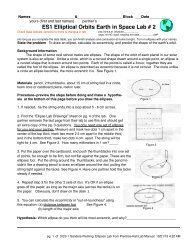


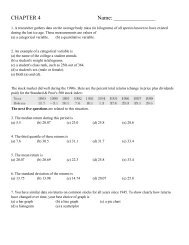


![';1asAu ro; las I sgeo8 leuo!]eslanuol aql utelqo o1 palenttouJ ue I ...](https://img.yumpu.com/49072782/1/190x221/1asau-ro-las-i-sgeo8-leuoeslanuol-aql-utelqo-o1-palenttouj-ue-i-.jpg?quality=85)
